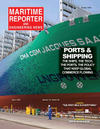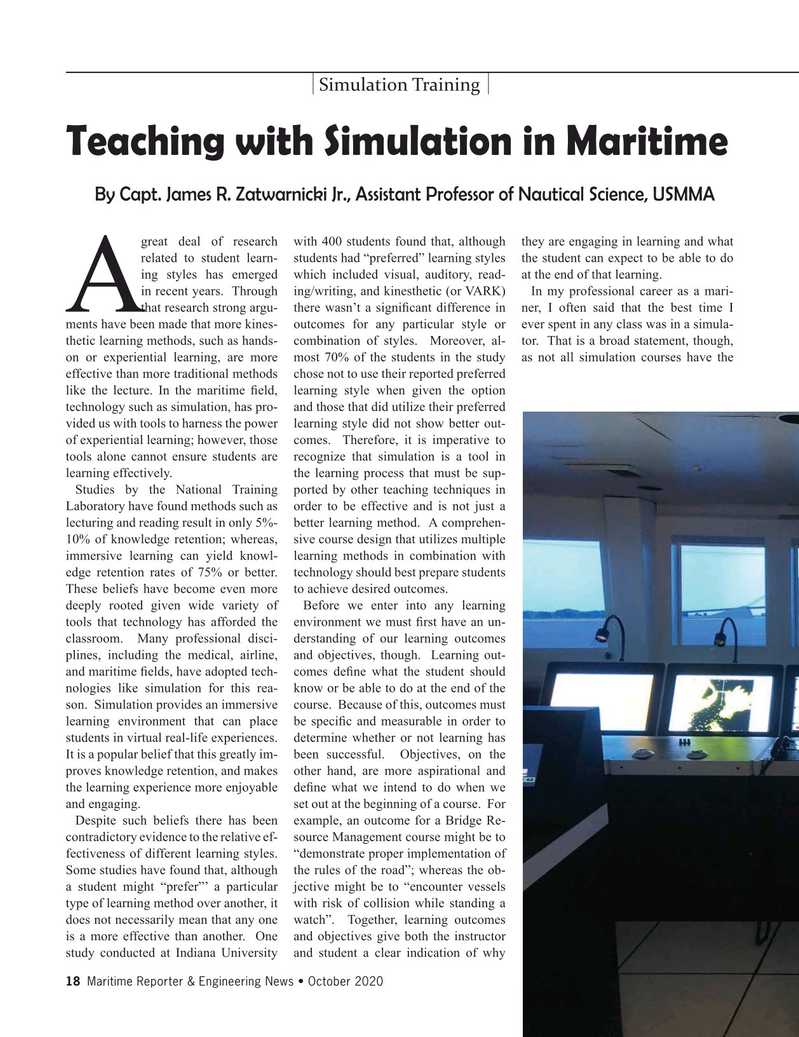
Page 18: of Maritime Reporter Magazine (October 2020)
Shipping & Port Annual
Read this page in Pdf, Flash or Html5 edition of October 2020 Maritime Reporter Magazine
Simulation Training
Teaching with Simulation in Maritime
By Capt. James R. Zatwarnicki Jr., Assistant Professor of Nautical Science, USMMA great deal of research with 400 students found that, although they are engaging in learning and what related to student learn- students had “preferred” learning styles the student can expect to be able to do ing styles has emerged which included visual, auditory, read- at the end of that learning.
in recent years. Through ing/writing, and kinesthetic (or VARK) In my professional career as a mari-
A that research strong argu- there wasn’t a signi? cant difference in ner, I often said that the best time I ments have been made that more kines- outcomes for any particular style or ever spent in any class was in a simula- thetic learning methods, such as hands- combination of styles. Moreover, al- tor. That is a broad statement, though, on or experiential learning, are more most 70% of the students in the study as not all simulation courses have the effective than more traditional methods chose not to use their reported preferred like the lecture. In the maritime ? eld, learning style when given the option technology such as simulation, has pro- and those that did utilize their preferred vided us with tools to harness the power learning style did not show better out- of experiential learning; however, those comes. Therefore, it is imperative to tools alone cannot ensure students are recognize that simulation is a tool in learning effectively. the learning process that must be sup-
Studies by the National Training ported by other teaching techniques in
Laboratory have found methods such as order to be effective and is not just a lecturing and reading result in only 5%- better learning method. A comprehen- 10% of knowledge retention; whereas, sive course design that utilizes multiple immersive learning can yield knowl- learning methods in combination with edge retention rates of 75% or better. technology should best prepare students
These beliefs have become even more to achieve desired outcomes.
deeply rooted given wide variety of Before we enter into any learning tools that technology has afforded the environment we must ? rst have an un- classroom. Many professional disci- derstanding of our learning outcomes plines, including the medical, airline, and objectives, though. Learning out- and maritime ? elds, have adopted tech- comes de? ne what the student should nologies like simulation for this rea- know or be able to do at the end of the son. Simulation provides an immersive course. Because of this, outcomes must learning environment that can place be speci? c and measurable in order to students in virtual real-life experiences. determine whether or not learning has
It is a popular belief that this greatly im- been successful. Objectives, on the proves knowledge retention, and makes other hand, are more aspirational and the learning experience more enjoyable de? ne what we intend to do when we and engaging. set out at the beginning of a course. For
Despite such beliefs there has been example, an outcome for a Bridge Re- contradictory evidence to the relative ef- source Management course might be to fectiveness of different learning styles. “demonstrate proper implementation of
Some studies have found that, although the rules of the road”; whereas the ob- a student might “prefer”’ a particular jective might be to “encounter vessels type of learning method over another, it with risk of collision while standing a does not necessarily mean that any one watch”. Together, learning outcomes is a more effective than another. One and objectives give both the instructor study conducted at Indiana University and student a clear indication of why 18 Maritime Reporter & Engineering News • October 2020
MR #10 (18-33).indd 18 10/6/2020 8:42:42 AM

 17
17

 19
19
